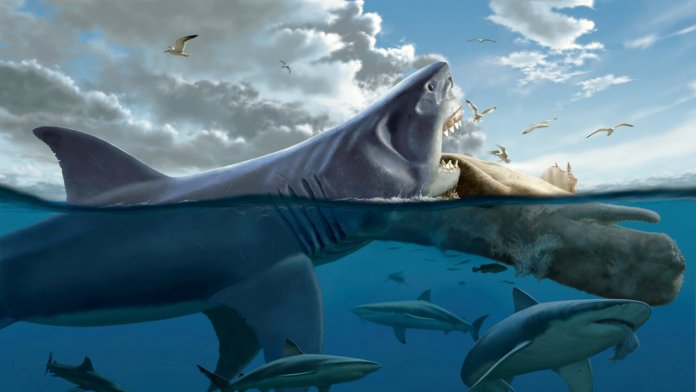Watch for the largest sharks in the world - very exciting. On TV, anyway. But if you are in their habitat, then become a potential food source for these ruthless underwater predators.
The good news is that most sharks, and there are 450 species in total, are not large enough to threaten you. The smallest shark is only 17 centimeters long. However, in the depths of the sea, there are monsters and larger ones. And for some of the largest sharks, humans are just lunch.
Top 10 largest sharks in the world
10. Mako shark - up to 4.45 meters in length, weight - 280 kg
 The color of mako sharks is one of the characteristics that distinguishes them from most of their relatives. The dorsal portion of these sharks can range from a deep purple to a bright blue. The sides are silvery and the belly is white.
The color of mako sharks is one of the characteristics that distinguishes them from most of their relatives. The dorsal portion of these sharks can range from a deep purple to a bright blue. The sides are silvery and the belly is white.
The main enemies of mako sharks are people who eat their meat. Themselves mako sharks prefer dolphins, squid, mackerel, and sea turtles for lunch. They definitely have a variety of food preferences.
No shark in the world can swim as fast as the mako shark. The speed and distance these creatures can swim are incredible. The constant speed of the mako shark is 35 km / h, and the fastest is 80 km / h.
9. Six-gill shark - 5.4 m, 590 kg
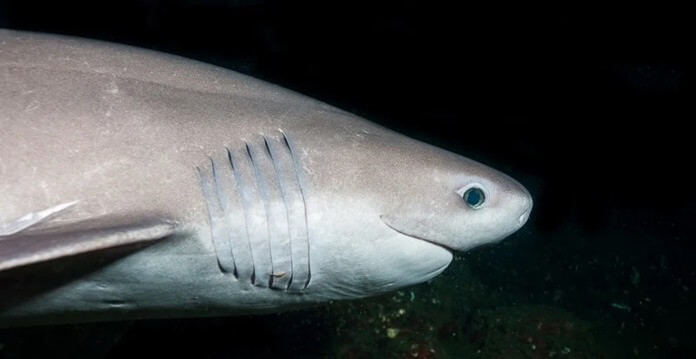 These deep-sea predators are distinguished by the following features: they have six pairs of long gill slits on each side of their broad head, comb-like teeth on the lower jaw, and a long tail.
These deep-sea predators are distinguished by the following features: they have six pairs of long gill slits on each side of their broad head, comb-like teeth on the lower jaw, and a long tail.
Six-gill sharks live on continental and island shelves in temperate and tropical seas around the world, in the Pacific, Atlantic and Indian oceans.
The diet of these huge sharks includes other sharks, seahorses, many species of large bony fish, and invertebrates, including squid and crabs. This shark is also known to eat dead animals such as seals and whales. As for interaction with people, it seems that the predator simply tolerates the presence of bipeds on its territory. Divers regularly observe juvenile sixgill sharks off the Pacific coast of Canada. Sometimes they swim close to divers and even surfers, but without threatening action or physical contact.
8. Tiger shark - 5.5 m, 1500 kg
 Perhaps even more dangerous than the great white, the tiger shark is known to hunt seabirds, dolphins and other marine life. Often hunting near the coast, at a depth of 6 or even 3 meters, tiger sharks can attack divers. Their attacks are more often fatal to humans than in the case of great white sharks. On average, 3-4 attacks of tiger sharks on humans occur per year.
Perhaps even more dangerous than the great white, the tiger shark is known to hunt seabirds, dolphins and other marine life. Often hunting near the coast, at a depth of 6 or even 3 meters, tiger sharks can attack divers. Their attacks are more often fatal to humans than in the case of great white sharks. On average, 3-4 attacks of tiger sharks on humans occur per year.
They got their name due to the stripes on the body, reminiscent of the color of a tiger skin.
7.Pelagic bigmouth shark - 5.7 m, 1500 kg
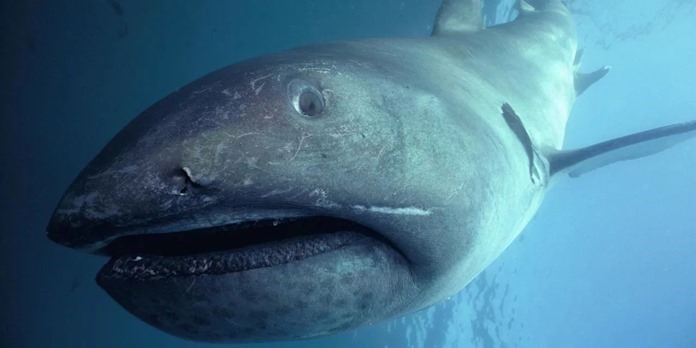 The appearance of this shark with a huge mouth immediately suggests the idea of horror films, where the diver will have a sad ending. However, do not be afraid, despite its appearance, the bigmouth shark feeds on plankton.
The appearance of this shark with a huge mouth immediately suggests the idea of horror films, where the diver will have a sad ending. However, do not be afraid, despite its appearance, the bigmouth shark feeds on plankton.
Perhaps it was this species that inspired people to create legends about monsters - half-kits, half-sharks.
Pelagic bigmouth sharks are very rare and of no commercial value.
6. Fox shark - 6.1 m, 500 kg
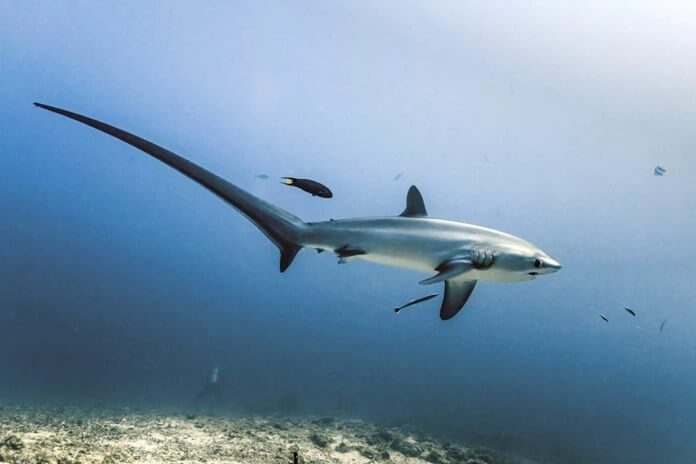 The genus of fox sharks (aka sea foxes) includes three species. The largest of these is Alopias vulpinus. These predatory creatures prefer the open ocean without visiting depths below 500 meters. In the photo, it is easy to see the most prominent part of the fox shark - this is the long upper lobe of the caudal fin. Sometimes it is equal in length to the entire body of the shark.
The genus of fox sharks (aka sea foxes) includes three species. The largest of these is Alopias vulpinus. These predatory creatures prefer the open ocean without visiting depths below 500 meters. In the photo, it is easy to see the most prominent part of the fox shark - this is the long upper lobe of the caudal fin. Sometimes it is equal in length to the entire body of the shark.
Humans are more dangerous to fox sharks than sharks are to humans. These creatures are hunted for their meat, skin, fins (used as a delicacy in soup) and liver.
When people appear nearby, the sea foxes get scared and immediately swim away. Although some divers can be stunned by the shark's tail, which it uses as a whip.
5. Giant hammerhead shark - 6.1 m, 454 kg
 Hammerhead sharks are very rare for humans, as they are on the verge of extinction.
Hammerhead sharks are very rare for humans, as they are on the verge of extinction.
This type of shark is distinguished by beautiful fins and a special head shape - strongly flattened, with large outgrowths on the sides. Among the most beautiful fish these underwater inhabitants are clearly not relevant.
4. Greenland shark - 6.4 m, 1000 kg
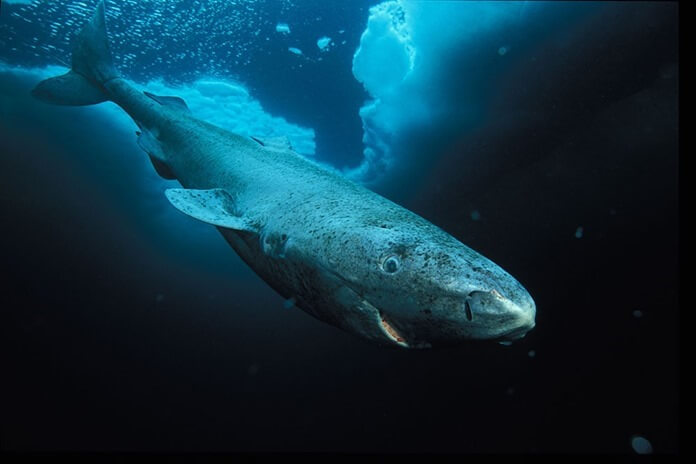 Although Greenland sharks are usually not aggressive, they are by far some of the largest sharks on the planet. And it's not worth approaching them without a good reason.
Although Greenland sharks are usually not aggressive, they are by far some of the largest sharks on the planet. And it's not worth approaching them without a good reason.
The diet of this shark mainly consists of fish and marine mammals, and due to its slow pace, it usually does not pose a danger to humans. However, there are stories of Greenland sharks attacking kayaks.
3. Great white shark - 6.4 m, 1900 kg
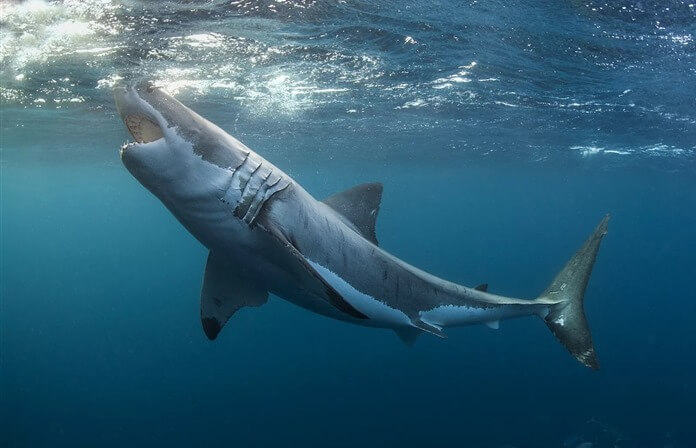 It may not be the largest shark on the list, but it is known as one of the most dangerous animals and the largest predatory fish on Earth. The size of an average adult is 4.4-4.6 meters, and its body weight reaches 520-770 kg. But there is a lot of (unconfirmed) information about great white sharks. According to her, the largest white shark can reach a length of up to 10 meters.
It may not be the largest shark on the list, but it is known as one of the most dangerous animals and the largest predatory fish on Earth. The size of an average adult is 4.4-4.6 meters, and its body weight reaches 520-770 kg. But there is a lot of (unconfirmed) information about great white sharks. According to her, the largest white shark can reach a length of up to 10 meters.
It is difficult to measure how big a great white shark really is. There are three reasons for this:
- These predators live in water, and it's not entirely safe to approach them, to put it mildly.
- Another problem is their incredible speed: great white sharks can reach speeds of up to 56 km / h.
- The third difficulty is that the bodies of white sharks are mostly water. Therefore, when they are on land, they dry out and become smaller in size.
It was the great white shark that appeared as the antagonist in the cult film Jaws.
2. Giant shark - 9.8 m, 4000 kg
 Despite its intimidating name, it is a harmless creature. It feeds not on divers and not even on smaller relatives, but on plankton (tiny animals that can be found near the surface of the water) and small fish.
Despite its intimidating name, it is a harmless creature. It feeds not on divers and not even on smaller relatives, but on plankton (tiny animals that can be found near the surface of the water) and small fish.
Their mouths are huge; they can be more than 1 meter wide. It would be logical to assume that a shark of this size should have long, sharp teeth, similar to those of a great white or tiger shark. However, the giant shark has only a few rows of small teeth. The large size of their mouth and the small size of their teeth directly match the shark's unexpected diet. In order to feed, giant sharks keep their mouths open while they swim. This is how they collect plankton from the water.
Giant sharks are thermophilic and prefer temperate and warm waters. In addition, they prefer to swim near the shore, near the surface, for which they have earned the nickname "sun fish".
1. Great whale shark - 20 m, 34,000 kg
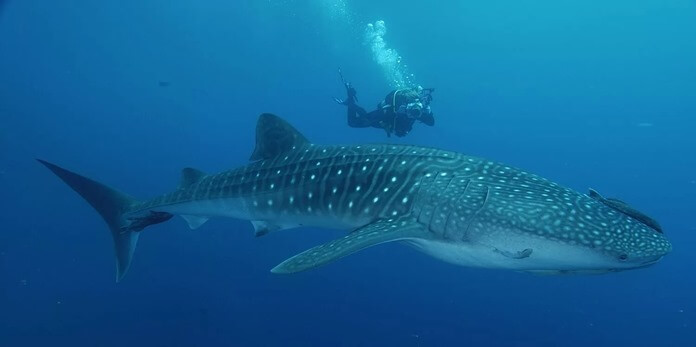 This is the largest living shark in the world. Luckily for most marine life - and us! - The favorite food of the whale shark is plankton.She does not have such sharp teeth as smaller sharks, but their number is very large, and reaches 15 thousand. To eat, the shark opens its heavy jaws and passively filters everything in its path using a special filtering apparatus formed by the gill arches.
This is the largest living shark in the world. Luckily for most marine life - and us! - The favorite food of the whale shark is plankton.She does not have such sharp teeth as smaller sharks, but their number is very large, and reaches 15 thousand. To eat, the shark opens its heavy jaws and passively filters everything in its path using a special filtering apparatus formed by the gill arches.
Preferring warm waters, whale sharks inhabit all tropical seas of our planet. They migrate every spring to the continental shelf of Australia's central west coast, where an abundant supply of plankton awaits them.
Despite their enormous size, whale sharks are quite calm and harmless fish. There is even a video on Twitter of a group of divers riding a whale shark.
The largest shark in history - 15-18 meters in length, weight - 47 tons
 When asked what is the largest shark in the world, science is currently giving a confident answer - the great whale shark. But it was not always so.
When asked what is the largest shark in the world, science is currently giving a confident answer - the great whale shark. But it was not always so.
About 20 million years ago, a predator appeared in the world, about which films and books are still being made. Its name is megalodon (Otodus megalodon, formerly known as Carcharodon or Carcharocles megalodon). For 13 million years, a huge shark dominated other living creatures in the oceans until it became extinct just 2.6 million years ago, during a global cooling.
Scientists suggest that the largest specimens of megalodons grew up to 18 meters in length. For comparison: length the largest snake in the world reaches 14.8 meters.
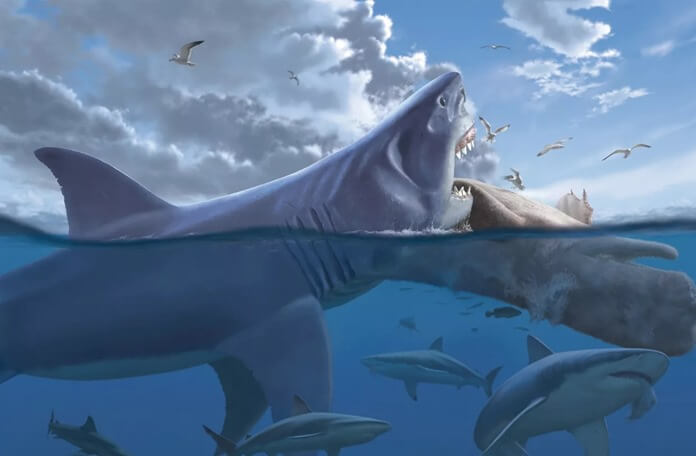 Megalodon's body size estimates are based on the size of the animal's teeth, which can be up to 18 cm in length. In fact, the word megalodon simply means "big tooth." It is curious that the teeth of megalodons were found on all continents except Antarctica.
Megalodon's body size estimates are based on the size of the animal's teeth, which can be up to 18 cm in length. In fact, the word megalodon simply means "big tooth." It is curious that the teeth of megalodons were found on all continents except Antarctica.
This giant shark ate whales and large fish, possibly other sharks. Its jaw - 2.7 meters by 3.4 meters - was large enough to swallow two adults sitting side by side.
The human bite force is about 1317 Newtons (N), the bite force of the great white shark is 18 211N. Megalodon bite strength ranged from 108,514 to 182.201N.
What did the megalodon look like?
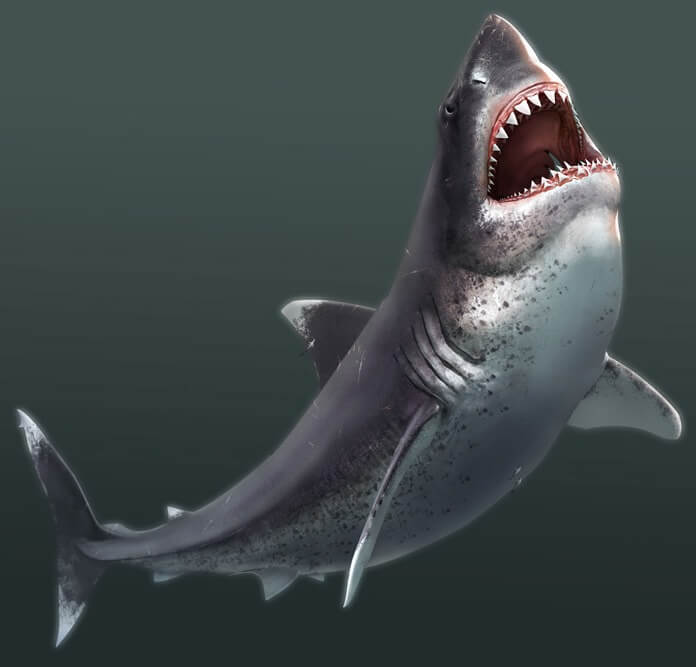 Most reconstructions show the megalodon to look like a great white shark. But scientists say this is not true.
Most reconstructions show the megalodon to look like a great white shark. But scientists say this is not true.
The megalodon probably had a much shorter nose than the great white shark and a more flattened jaw. It had very long pectoral fins to support its gigantic weight and size.
And the ancestor of the modern great white shark lived near the megalodon. Some shark researchers believe they could even compete with each other.
Could a megalodon exist today?
If an animal the size of a megalodon still lived in the oceans, scientists would know about it.
Sharks leave their telltale marks - bites on other large marine animals - and their huge teeth continue to litter the ocean floors. Not to mention the fact that being a thermophilic creature, the megalodon will not be able to survive in cold deep waters, where it has a better chance of remaining unnoticed.

